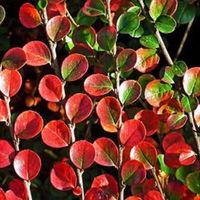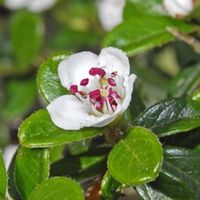
Cotoneaster
(Cotoneaster horizontalis)
Country of Origin : Western China
Bonsai Styles : Informal upright, root-over-rock, clasped-to-rock, twin- trunk, semi-cascade, cascade, slanting
Zone : 5 – 9
There are both evergreens and deciduous shrubs among these popular garden shrubs used to make Cotoneaster bonsai tree.
A cotoneaster plant is a highly suitable candidate for bonsai, thanks to its small leaves, flowers, and fruit, and they are available in a whole range of bonsai styles. Bonsai enthusiasts will find that this popular garden shrub has nearly everything they could possibly want.
In Bonsai, Cotoneaster horizontalis is one of the deciduous species that is commonly used by bonsai enthusiasts.
In temperate and subtropical zones, it is one of the most popular garden shrubs, and it is, without a doubt, the best choice for a new bonsai practitioner.
The leaves are dark green and shiny, the flowers are white and pink, and the berries are orange-red.
The genus contains about 200 species, many of which are suitable for bonsai. They are available in prostrate, spreading, and upright varieties, so they can be cultivated in a wide range of bonsai tree styles. Few of the most popular Cotoneaster bonsai tree varieties are as follows:
- Cotoneaster horizontalis – A deciduous variety of Cotoneaster bonsai tree, this tree is mostly trained as a bush in bonsai styling. It produces a great bonsai specimen with dark green-shiny leaves, pink flowers and bright orange fruits. This cotoneaster horizontalis bonsai tree has a flat-growing habit and a distinctive, herringbone-like branch structure. Along straight shoots, it bears many leaves on each side. In midsummer or the following spring, new shoots emerge from the bases of leaf stalks. Cotoneaster horizontalis is also particularly preferred for making root over rock bonsai style.
- Cotoneaster adpressus praecox – This cotoneaster tree variety displays a striking fall display as its leaves turn scarlet and its berries turn bright red.
- Cotoneaster microphyllus – Unlike horizontalis, this variety is evergreen and has slender and darker leaves. However, both the varieties display same growth pattern. The flowers are white in color and microphyllus produces fewer fruits than horizontalis.
- Cotoneaster conspicuus decorus – This variety is a more compacted variety of cotoneaster bonsai tree. In spring, it is covered with fragrant white flowers.
- Cotoneaster skogholm – This is a dwarf variety of cotoneaster bonsai tree. This bonsai tree produces very small leaves and large berries.
- Cotoneaster congesta – This variety is advised in case you plan to grow a very small cotoneaster bonsai tree.
- Cotoneaster integrifolius – Also called as entire-leaved cotoneaster or Wintergreen Cotoneaster is a low growing variety of cotoneaster tree.
There are many different types and sizes of cotoneaster bonsai, so you will never have a problem finding one that suits your taste.

Cotoneaster tree’s leaves are very small, glossy, and dark green in summer and turn shades of orange and red in the fall.

As the year progresses, bright orange or red berries are produced consistently on the Cotoneaster tree, right through the winter.

These tiny, spherical flowers cover the Cotoneaster tree with pink and white blossoms in spring.
Best location to keep Cotoneaster Bonsai
Cottoneaster bonsai tree thrives in full sun all year round.
However, the cotoneaster bonsai tree can be brought into semi-shade without any problems, though this will affect the fruit setting on the tree.
Moreover, they can also be displayed indoors for a short time with no harm to them at any time of year.
A temperature range of 25 – 90 °F ( -3 to 32 °C) is ideal for the cotoneaster bonsai tree.
Most cotoneaster trees can be left outdoors in winter. However, the tree needs to be protected from prolonged cold winds and winter rain.
Take the tree into a shed or garage if the temperature drops below 19°F (-7°C) for more than a day.
Propagation of Cotoneaster
Cotoneaster can be sown in spring by using stratified cotoneaster seeds.
In summers, plant cotoneaster plant using softwood cutting.
In winter, plant cotoneaster plant using hardwood cutting.
Watering Cotoneaster Bonsai
Often, gardeners use cotoneaster tree to cover dry bank areas as there is little else to grow, as cotoneaster tree is relatively less water demanding.
However, when grown in bonsai containers, the cotoneaster bonsai tree does not like dry soil.
The bonsai soil should only be watered when it is on the dry side in summer.
The soil should only be just moistened in winter. However, in case of evergreen varieties of cotoneaster bonsai tree, make sure there is sufficient amount of water in soil even in winters.
Protect the cotoneaster bonsai tree from prolonged winter rain.
Avoid over-watering as it will cause root rot.
Wiring Cotoneaster Bonsai
During the spring, before the buds emerge, wire the trunk and branches of the cotoneaster bonsai tree.
To protect the soft branches of the cotoneaster bonsai tree, wrap them with raffia.
Wire should not be left on the branches for more than a year or one growing season.
U can use guy wire for wiring the cotoneaster bonsai tree.
Pruning Cotoneaster Bonsai
When to prune Cotoneaster bonsai?
How to prune Cotoneaster bonsai?
In late winter or early spring, major branches must be pruned (Three weeks after repotting in case you have repotted the plant). Throughout the growing season, new shoots are continuously scissor-trimmed, resulting in dense, twig-like growth.
As the growing season progresses, cut back vigorous shoots that appear.
You should seal all wounds as soon as possible to prevent the spread of fungal spores, particularly coral spot, which attacks living tissue.
Pinching Cotoneaster Bonsai
As soon as unwanted adventitious growths appear, remove them immediately.
It is almost a full-time job to trim and pin large cotoneaster bonsai trees.
A sharp pair of scissors should be used to cut through all vigorous shoots.
A network of short spurs will gradually form on other, less vigorous shoots once they are cut back to two or three leaves.
While it is tempting to just snip the foliage off the branches like a hedge, this method doesn’t give you much control over the growth pattern and structure of the branches of the bonsai tree.
After midsummer, avoid pinching, as you will eliminate the flowering shoots that produce the next year’s flowers.
Repotting Cotoneaster Bonsai
When to repot Cotoneaster bonsai?
Repot younger specimen of cotoneaster cypress bonsai every year or 2.
Older specimen (of cotoneaster bonsai tree can be repotted in almost 3 years.
Many Japanese literature recommend that the cotoneaster bonsai tree must be repotted after flowering. Generally speaking, however, in Europe and North America, flowering bonsai produce the best results when they are replanted in early spring or late winter.
When the tree becomes 10 years old, repot the bonsai tree whenever the tree is pot bound.
Use a basic soil mix or mix.
OR
You can use a basic soil mix with 20% grit.
OR
You can also use a bonsai soil mix with one part leaf mould, one part sharp sand and two part loam. (1:1:2)
OR
Or you can use 50% grit and 50% organic matter.
Must Read: Bonsai Soil Recipes
Must read : Choosing the right bonsai container
Feeding Cotoneaster Bonsai
Apply feed to the cotoneaster bonsai tree after the tree has flowered.
Use a general fertilizer in the spring and early summer, then switch to a low-nitrogen fertilizer in late summer.
OR
Up until the bonsai tree flowers, apply feed every two weeks. After that, apply nitrogen free feed once a month until late summer.
Diseases and pest of Cotoneaster Bonsai
A toxin found in the Cotoneaster tree is highly poisonous to some plants. Ensure that tools are clean after use by using methylated spirits. Also, it is advisable to sterilize oil tools with a flame before and after use on cotoneaster bonsai tree.
A cotoneaster bonsai tree is prone to rust and fireblight.
Particularly, fireblight is a serious threat to cotoneaster. Shoots that appear black and leaves that appear withered as if they have been burned need to be treated immediately. Plant parts affected by the fireblight should be removed and burned.
Flowers may also be infected by fireblight fungi. It is typically fatal and incurable.
Aphids and red spider mites attack plants occasionally, but can be controlled easily either by hands or insecticide.
Cotoneaster bonsai care
When potted in a bonsai container, the trunks and branches of cotoneaster bonsai trees are slow to thicken.
Plant your bonsai in large bonsai pots or open ground for a year or two if you want the trunk to thicken.
Cotoneaster bonsai tree won’t grow well in waterlogged conditions. It is crucial to choose a free draining bonsai soil.
Providing overhead protection in prolonged wet conditions is also advisable.
In spring, or following pruning, a new straight shoot grows from every leaf axil. This predictable growth behavior makes it easy for a bonsai beginner to judge the exact origin location and direction of the new growth.
Eventually, making it easy to plan and develop a beautiful and neat branch structure and a well organized foliage cloud.
If you want to shape existing or new branches, simply cut them back to a leaf facing the direction you want the new growth to grow. This reduces the need of wiring.
However, as new shoots grow so prolifically, trimming them regularly can become tedious.
What to look for when buying Cotoneaster Bonsai
Do not buy a cotoneaster bonsai tree with thin roots or weak trunks.
Make sure that the tree’s roots are healthy and are holding the bonsai tree firmly in its bonsai pot.
Choose a cotoneaster bonsai specimen with well-developed roots and a well-developed trunk as these plants take a long time to thicken in bonsai containers.

